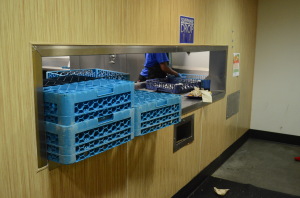
“From a customer’s perspective, the more food that is wasted translates to higher food cost, that in turn causes meal plan pricing to rise.” -Suzanne Paltz

After the university’s Hunger Awareness month was initiated in Sept. 2014, some students may be surprised by the amount food waste collected by Georgia State dining halls.
Suzanne Paltz, university assistant director of PantherDining, initiated Hunger Awareness and it was the first time in the school’s history that it was practiced.
“The purpose of Hunger Awareness Month is to inform our customers and employees on ways to reduce and eliminate food waste,” Paltz said. “I firmly believe that awareness helps bring about change.”
To ensure accuracy of the food waste weight, napkins and silverware were removed and the scale was adjusted for the weight of the bowl or plate being weighed.Then a digital portion scale was used to measure and record individual weights.
Plate waste totals were recorded weekly and a total was calculated at the end of the month.
According to Paltz, at the end of September, students at Piedmont North and Patton Hall combined 60,884.22 pounds of food waste.
Currently, PantherDining offers two plate sizes to their patrons: medium and large. Paltz said the majority of students use large plates and load them with food, creating waste which affects students and the university.
“From a customer’s perspective, the more food that is wasted translates to higher food cost, that in turn causes meal plan pricing to rise,” she said.
Lauren Robinson, a sophomore business management major, said she is shocked to hear about the statistics about dining hall food waste.

“When I first heard that Patton and Piedmont dining halls were doing Hunger Awareness Month, I didn’t understand why,” Robinson said. “But by hearing these statistics I now understand why this was created, because so much food is actually being wasted.”
PantherDining staff were determined to achieve their goal of reducing food waste associated with patrons overloading their plates, according to Paltz. This was accomplished by implementing two waste management systems: LeanPath and SOMAT, and a study place called Healthy Habits at the Piedmont North and Patton dining halls.
LeanPath is a food waste prevention company which created a system to track food waste and help food service organizations fight food waste, according to the company’s website.
“We use LeanPath Waste Management System to help control pre-consumer food waste,” Paltz explained. “LeanPath also weighs all post-consumer food waste, generates reports on results and guides managers and employees on suggested ways to waste less.”
Paltz said LeanPath is also used to weigh post-consumer waste to better educate customer on taking only what they can eat.
In an effort to ‘go green,’ other Georgia State dining halls implemented practices such as the re-use of food items in soups, casseroles and other dishes. In addition, all pre- and post-consumer waste is pulped and extracted through a Somat system, according to Paltz.
The Somat system is a Dehydrator waste management system processing waste for medium size foodservice operations to very large institutions, according to the company’s website.
“The food is crushed into a confetti like mixture that is then picked up by a hauler that transports the mixture to a composing facility,” Paltz said. “Then at the composting facility, the mixture is turned into compost and re-used in landscaping throughout the Atlanta area.”
Paltz attested to the success of both LeanPath and SOMAT’s automated waste management solutions.
“When I first came to Georgia State in 2009, we implemented the LeanPath and SOMAT waste management systems in Patton Hall to bring awareness and reduce food waste,” Paltz said. “With the success of the waste management systems in Patton Hall, we implemented them in the new Piedmont North dining Hall in 2011 and the methods garnered the same success.”
Paltz said due to the success of the LeanPath’s and SOMAT’s automated waste management systems, university dining halls experienced a dramatic reduction in food waste this year and saved a considerable amount of money.
“The Georgia State dining halls have eliminated 61 tons off food waste, which is the equivalent of 12 elephants of pre-consumer waste,” she said. “We have also saved $161,000 in total waste avoidance.”
Paltz also said she is pleased with the success of Hunger Awareness month and believes that Georgia State is on its way to being a completely green school.
“The LeanPath and Somat system will be practiced more in the near-future because we believe that food waste is preventable and we’re working towards a zero waste environment,” she said.
Sophomore student Jordan Johnson said Hunger Awareness Month has impacted students in both dining halls.
“During that whole month, I [saw] a good amount of people actually get less food and not waste it as much,” Johnson said. “By making us aware of food waste a lot of people changed their eating habits.”
